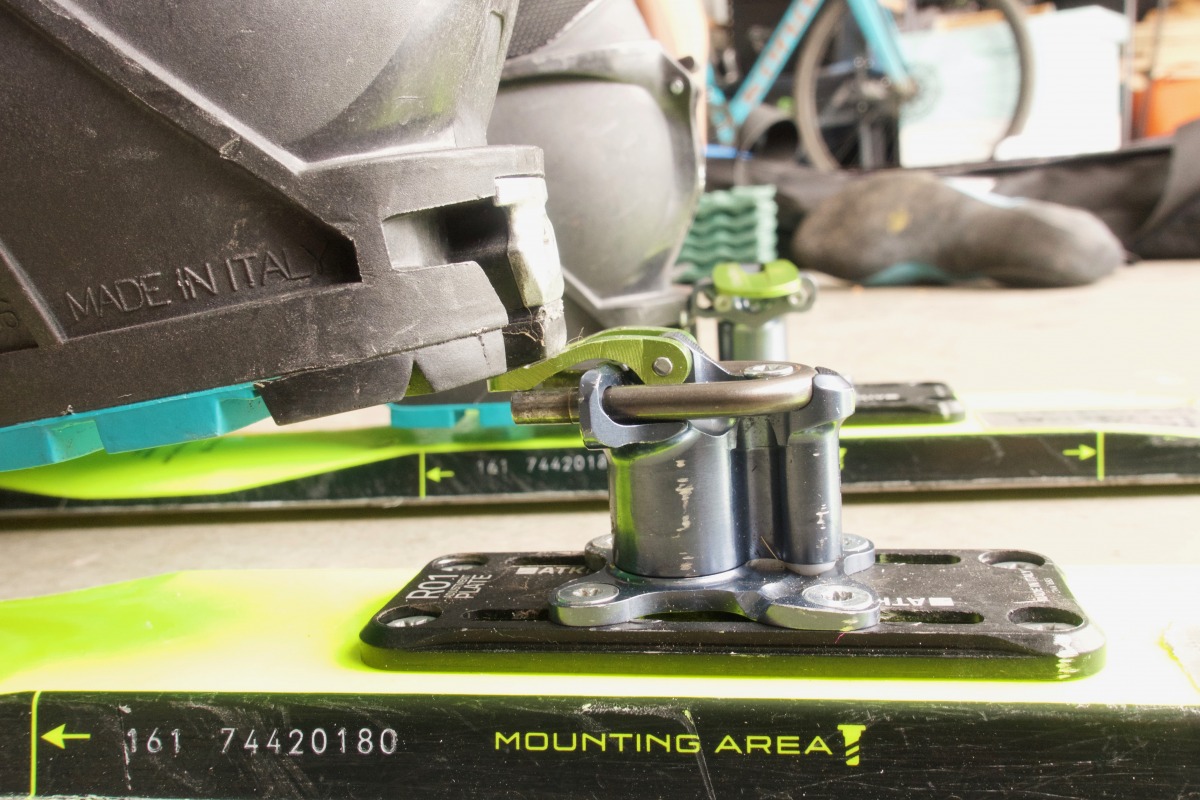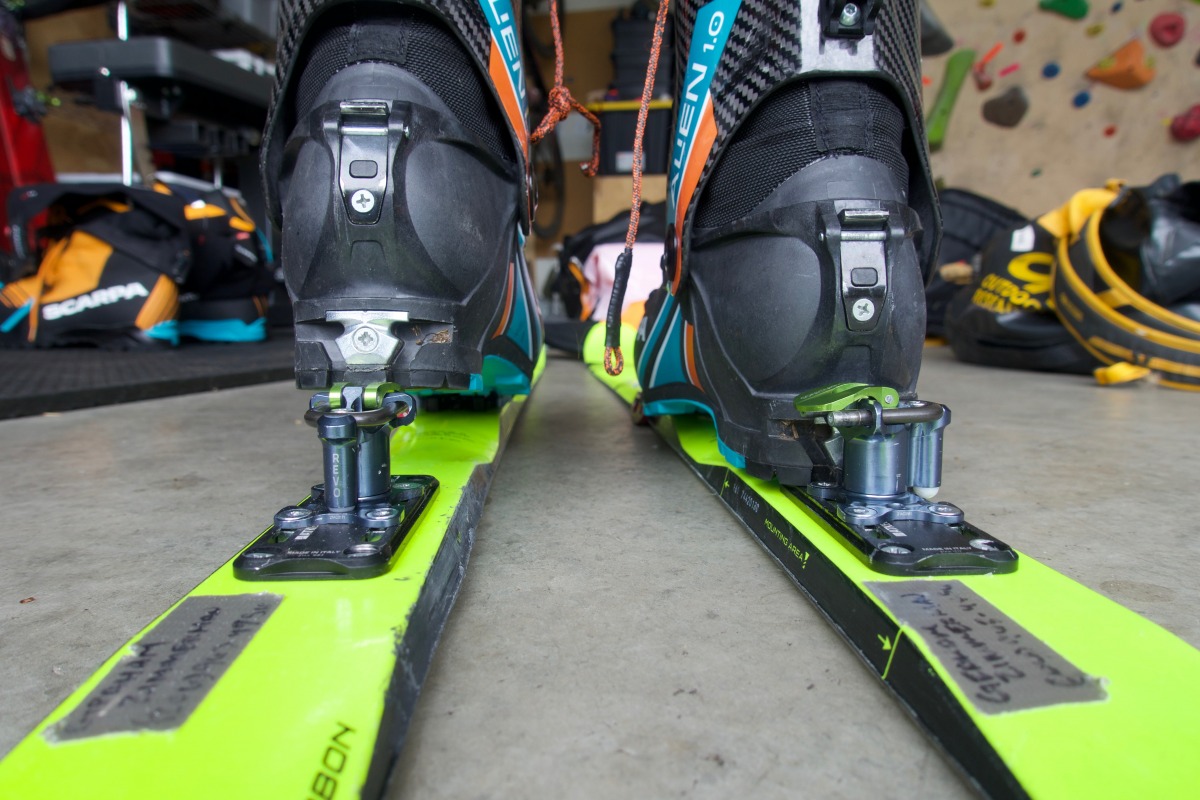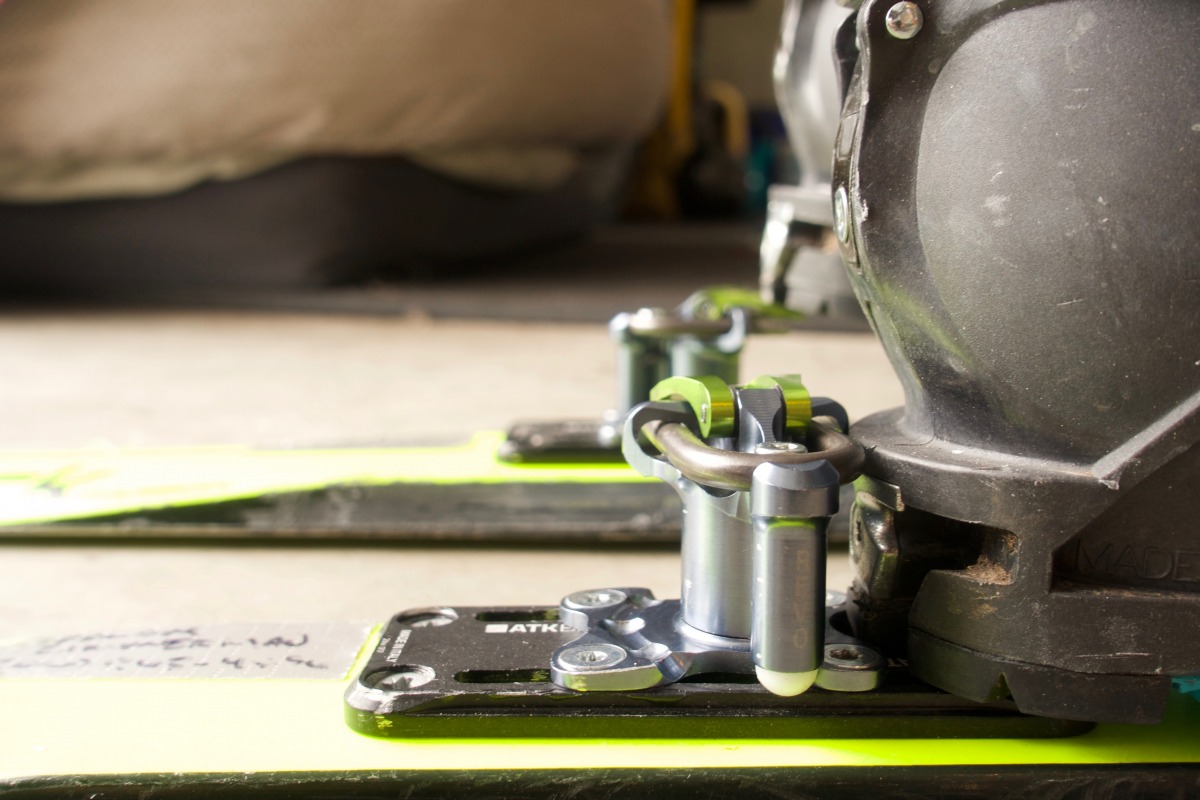
Find tuned toe pieces from ATK in their rendering of the Revolution World Cup.

The heel pieces too, are a testament to a detail oriented build out and gram counting. Photo: Graham Zimmerman.
Read up on the first and second look at the ATK Revolution World Cup here.
As a mountain climbing athlete – I am unfamiliar with the art of racing. So, as I stood amid the pack of hundreds of skiers at the base of the Crested Butte ski area at midnight, I looked at Forest Woodward and asked, “what the hell have you gotten me into?”
Ahead lay nearly 40 miles of skinning up and over a series of mountain passes in the Elk Range of Colorado. The finish line was downtown, Aspen. Each skier had a backpack full of survival equipment, water, and food. In the dark of night, anticipation was palpable. Headlamp beams waved around the crowd as folks made final preparations for the firing of the starting gun. Some of you reading this know the drill and can empathize.
Forest was my partner for the race. He smiled at me, “Honestly, I have no idea.”

The honest look from Forest when asked “what the hell have you gotten me into?” Note the big smile, it’s the race start. Photo: Graham Zimmerman.
He and I had been on many adventures together – from first ascents of granite walls in Canada to an unsupported crossing of the Alaskan Peninsula – but this was our first time bibs-pinned-on type racing together. In the past, racing had been his thing. He had been training hard for ultra marathons. Now he is working on a Master in Fine Arts. He’s refined. I had been preparing for a climbing expedition, so I was fairly fit, but we both knew it would hurt. We also knew we didn’t have a chance of winning – we were there to participate. All I could think about was the line from Hunter S Thompsons’s The Curse of Lono as he tried to dissect the attraction of marathon running.
“What kind of sick instinct, stroked by countless hours of brutal training, would cause intelligent people to get up at 4 in the morning and stagger … for 26 ball-busting miles in a race that less than a dozen of them have any chance of winning? … They do not enter to win. They enter to survive and go home with a T-shirt.”
I was pretty sure there was a t-shirt at the end of this race – it seemed as good a reason to get to Aspen as anything.
I also hoped that I had a trick in my back pocket. With dozens of expeditions to the world’s big mountains under my belt and a personal propensity for spending time in “the pain cave,” I knew that I could keep skiing as long as needed to reach the finish. I had also spent significant time letting my gear geek flag fly as I’d prepared for the race.
A bag full of the lightest survival equipment I could find was on my back – most of it poached from my high mountain gear arsenal. The shoulder straps of my pack were mounted with water bottles. Minor tweaks, but essential tweaks.
I carefully picked out my clothes and chose my snacks based on their macronutrient loads. But it was on my feet where the gear was the most refined.

The “light” side of the gear selection for my first ever EMGT.
The boots I wore, Scarpa Alien 1.0s, were essentially running shoes with carbon supports on the sides, and my skis, Fischer Alp Attacks, with the bindings, weighed in at a mere 750g each. And those tiny mean and green bindings – the ATK Revolution World Cups held the whole thing together. (Full disclosure, I’m a Scarpa ambassador.)
I had been provided those bindings by a friend who asked me to test them out and see what I thought. I was dubious. As an alpinist with a 190lb frame, I am hard on equipment. Considering that I had a track record of breaking larger, tougher bindings – I always assumed that a pair of super ultra-light racing ski bindings would not be a great fit for my needs. But as someone who loves equipment that doesn’t weigh much – I was interested in trying them. How long would they last? I wondered.
Eyeing and handling something as seemingly ephemeral as the ATK Revolution World Cups is enough to sow doubts but not exactly cast aspersions: They are so light. If you are coming from the freeride realm, you might head scratch; from the touring-light side, you might kick the sidewalls but fancy something in the 200 to 300-gram range more your style. Or, if you skimo race or plan on suffering less, but don’t rule out suffering altogether on something like the Grand Traverse, the bindings might be just the ticket you seek.

A clean shot of the toe piece. If you run leashes, the hole near the lever tip is the girth hitch point. And, the screw labeled “soft, medium, hard” is the adjustment for the Uphill Hardness Variator — tech speak for a means to adjust the retention.
Here are the basic specs:
Weight: 106g/binding (toe + heel piece).
Adjustment plate weight: 35g (which is optional and I opted for).
Lateral release: fixed at 8.
Vertical release: fixed at 9.
Material: 7075 Aluminum, titanium U-spring, POM (a thermoplastic).
Riser: ~+35mm flipped over the pins.
Features to maybe write home about:
-rotating bushing on the ends of the titanium u-springs to make heel entry a bit smoother.
-a near closed toe piece, a difference from the ATK SL race binding where the springs are exposed.
-the toe piece also features ATK’s Uphill Hardness Variator, which allows one to adjust the toe lever and its retention in the case the pin inserts become worn over time.
-ATK says the toe also incorporates a “snow pack proof system” that prevents snow buildup under the toe. All I can say is I have had no problems with snow buildup.
-an adapter for ski crampons is optional.

A side view of heels engaged.

A side view of the riser engaged (foreground) and flat mode.

Heel riser engaged on the left and the never used flat mode on the right.
During my training days outside my home in Bend, OR, I had put them through their paces ranging from long days of touring to a couple of steep descents. While using them, I had forgotten that I was wearing a dainty pair of 110g bindings, and while the 62mm underfoot skis left me wanting more surface area in fresh snow – the bindings were never a hindrance.
But, standing at the start – with 10-14 hours of skiing ahead of me alongside many transitions – I looked down at the bindings and wondered if they would hold up. I had faith, mind you, being a worshipper at the altar of light and fast, but I still second-guessed.
If the bindings didn’t hold up, it would be a massive pain in my ass. And likely, for Forest too. I mean, this is a partnership race, after all.
This will be the real test, I thought.
The starting gun sounded.
We headed off into the dark.

Night-vision later in the race. Photo: Graham Zimmerman.

The racing, I’m certain, made us better people. And the light skis, boots, and bindings made us better too. Photo: Graham Zimmerman.
Reaching the top of the ski area, we ripped skins and pointed skis downhill. As we pulled into the long climb leading towards Star Pass – we tried to skate into the dark valley ahead, but the snow was sloppy. So we stopped, transitioned, and started skinning.
We experienced variable conditions ranging from isothermal snow to powder as we skinned up. We didn’t worry about it. Occasionally the stars were out, peeking through the trees above, and then it would be terrible with blowing snow and low visibility. I didn’t love the skiing, even when it was good. I’d lost track of that, but it didn’t matter – I kept going. The skiing was work – it was something that I had to do to achieve my goal. It felt good.
Sunrise caught Forest and me as we descended from Star Pass. Fresh snow that would have been perfect in big skis made my 750g toothpicks want to dive. I drove them hard. I sat in the back seat, pulling up on the skis and struggling to keep them on top of the snow. The bottom of the descent came as a relief. We transitioned. I changed my socks and stuffed my face with Fritos. We kept going.
From there, it was a rolling six hours of skinning up and sliding down – often in a whiteout.
“I’m putting my headphones in,” Forest said.
I did the same and considered putting on a metal album – instead, I put on a fantasy novel.
“Sometimes, the prize is not worth the costs. The means by which we achieve victory are as important as the victory itself,” the narrator read aloud. Oh yeah, that was what I needed thinking about that t-shirt waiting at the finish line.
I had been told that the final section, Richmond Ridge, was tantamount to a horrific roller coaster. But, sometimes, having meager expectations can be a good thing. As we scooted through trees covered in fresh snow, we felt good. We stepped up our speed. Up and down we went trying to read the terrain as we skied, skated, and skinned.

The ping pong ball universe in all its glory- mid EMGT 2022. Photo: Graham Zimmerman.
“In the end, all men die. How you lived will be far more important than what you accomplished,” the narrator read, telling a story about a king in a made-up mythical land. I probably hadn’t needed that, but it made me smile. Death and glory, or at least I was going to get my goddamn t-shirt. Also, I decided that I was going to have a Margarita.
I’ll interrupt this tale again for a moment. This is time to note the touring functionality of such a svelte binding. Which, at this point in the race, we had done plenty of. As a race binding, you’ve got the option for quick transitions by flipping the lone riser over the pins and striding along. Flip the riser up, rip the skimpy pink skins (you’ve got to have the skimpy pink skins), smash the boot heel down but in a mindful way, and you’re locked and ready as far as the binding is concerned.
The delta is near-perfectly flat without the plate installed; the heel rests maybe ~0.4mm lower than the toe. Add some height to the heel pins with the plate, and the delta is ~+4.3mm. That’s on par with the delta for the Plum R-170s my friend is testing across the river. With the massive range of motion racing boots provide, striding with the riser over the pins feels pretty damn good. And this is where I’m speaking to flat mode purists. In comments, you might read of a flat mode by rotating the heel 90-degrees from pins forward. The heel will rotate. But, this is where I’ll defer to those more experienced as the editor here reached out to Doug Stenclik to get his take on the flat mode or lack thereof.
“This has been the bane of CCBC. You need to intentionally mount it with a 5.5mm spacing instead of 4mm spacing,” noted Stenclik. “It is not listed that way on their website, but apparently if you email them that’s what they will say. I believe this would change release characteristics, but we had to buy a customer a new ski because he wanted the mysterious ‘flat’ mode. A flat mode should be irrelevant with an F1 LT or lighter and a little technique.
“That is a lot of editorial to say ‘Yes’ if you incorrectly mount the binding, [there’s a flat mode]. In the photo that would never work for flat because if the ski is flexed at all the boot will get hung up on the tower.”
The photo Doug was sent is posted below. Note, in flat mode, that is a tight kiss between boot heel and tower. It runs clean, meaning there’s no interference between boot and tower, but any meaningful flex in the ski, and yes, that would be cause for interference. In my experience, I’d agree with Doug, that the range of motion on some light boots doesn’t necessarily warrant a true flat mode to stride efficiently. I never once in all my time in this binding rotated the heel into true flat.

Although I aspire to kick and glide like a Lillehammer local, I never rotated the heel piece to engage the true flat mode. The very ample range of motion with the Scarpa Alien 1.0s made striding on flat and inclined terrain smooth.
Have no fear; these bindings are legit. And many have moved towards the lightest is the best option. I have not taken my mind and body there yet. For the job I selected this binding for, it has been ideal. I’m not necessarily mounting my next pair of spring mountaineering skis with a 100g binding and calling it good for any high consequence descent. I may be an alpinist, but I know what I know and have a well-defined comfort zone.
Back to the race; finally, we made it to the top of the Aspen Ski area. It wasn’t quite a whiteout, but we couldn’t see the view either. We ripped our skins, locked our heels, and pointed our tips towards town for 3200 feet of skiing on corn snow in flat light.

The selfie documenting our traverse to post-race beverages.
We pulled over the finish line after 11:58, Forest finishing right before me. It was a very middling time, but it was our time, and we were stoked. I pulled off my skis, unlocked my boots, hugged our dear friends who were there to meet us, and grabbed a coffee. We got our T-shirts, and the race organizers even gave us a participation medal.
The funny thing was that as I sat down and lay my skis on the ground next to me, it was the first time I had thought about the bindings since starting the race. While I had used them constantly for the past 12 hours, I had never given them any mind. So my moment of concern at the start line that I might break them and effectively strand myself out in the wilds of the Elk Mountains had proven unjustified. Instead, the little green racing machines carried the day.
Wow, I thought, looking at them, five stars.
I wondered what else they could do.
“Margarita?” Forest asked, pulling me out of my daze. He was pointing out a little Mexican joint down the street.
I cast aside thoughts of skiing. They could wait.
“Hell yeah,” I replied.
Shop for the ATK Revolution World Cup..
Graham is a professional climber, a Piolet D’Or Recipient, a community leader, a vocal climate activist, and an award wining creative. He is also simply a mountain lover striving for a balance between people, nature, and exertion.
